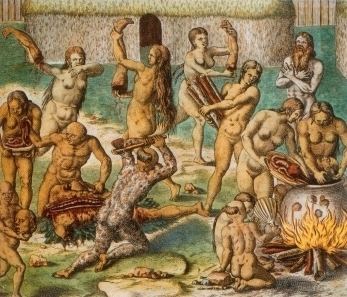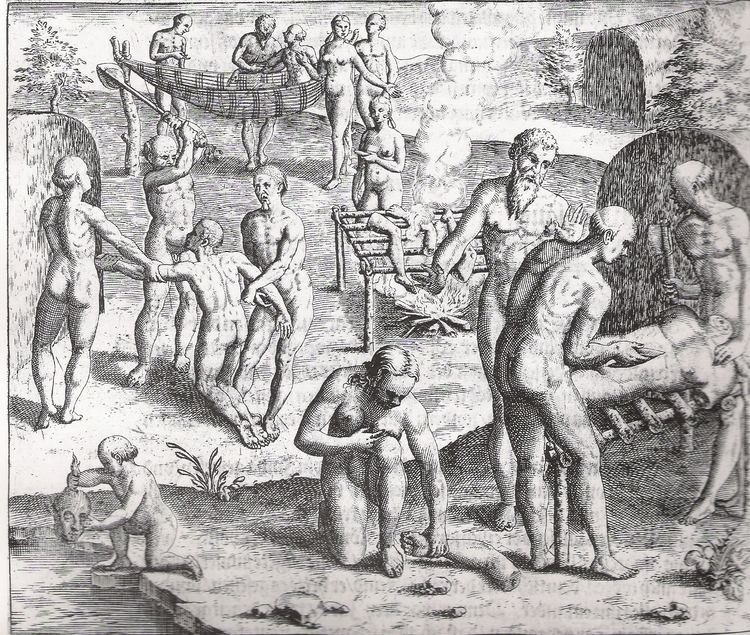Name Hans Staden | ||
 | ||
Books Hans Staden's true history, Hans Staden, the True History of His Captivity, The True History of His Captivity | ||
Hans staden theatrical trailer
Hans Staden (c. 1525 – c. 1576) was a German soldier and explorer who voyaged to South America in the middle of the sixteenth century, where he was captured by the Tupinambá people of Brazil. He managed to survive and return safe to Europe. In his widely read account describing his travel and captivity, he claimed that the native people that held him captive practiced cannibalism.
Contents
- Hans staden theatrical trailer
- Hans staden
- Trips to South America
- Narrative of his captivity
- Work as a Go Between
- Cannibalism
- Later life
- Staden in film
- References

Hans staden
Trips to South America

Staden was born in Homberg in the Landgraviate of Hesse. He had received a good education and was in moderate circumstances when desire for travel led him to enlist in 1547 on a ship that was bound for Brazil. He returned from this first trip on 8 October 1548, and, going to Seville, enlisted for a second trip as a volunteer in an expedition for Río de la Plata which sailed in March 1549. On reaching the mouth of the river, two ships sank in a storm. After vainly trying to build a barque, part of the shipwrecked crew set out overland for Asuncion. The rest of the crew, including Staden, sailed upon the third vessel for the island of São Vicente, but were also wrecked. Staden, with a few survivors, reached the continent in 1552.

A few weeks later, while engaged in a hunting expedition, Staden was captured by a party belonging to the Tupinambá people of Brazil, an enemy group of the Tupinikin people and their Portuguese allies. As Staden was part of a Portuguese crew, he was perceived of as an enemy of the Tupinamba and they carried him to their village (the predecessor of today's Ubatuba) where he claimed he was to be devoured at the next festivity. However, Staden allegedly won the favor of the Tupinamba Chief Cunhambebe by translating between the Tupinamba and European traders as well as predicting a Tupinikin attack on the tribe, thus his life was spared. Furthermore, when Staden later claimed to have cured the tribal king and his household from illness through the power of prayer and Christianity, the Tupinamba embraced him and called him "Scheraeire," meaning "Son, do not let me die." The Portuguese tried several times to negotiate for Staden's ransom, but the Indians declined all overtures. At last he made his escape on a French ship, and on 22 February 1555, arrived at Honfleur, in Normandy, and from there went immediately to his native city.
Narrative of his captivity

After his return to Europe, the support of Dr. Johann Dryander in Marburg enabled Staden to publish an account of his captivity, entitled Warhaftige Historia und beschreibung eyner Landtschafft der Wilden Nacketen, Grimmigen Menschfresser-Leuthen in der Newenwelt America gelegen (True Story and Description of a Country of Wild, Naked, Grim, Man-eating People in the New World, America) (1557); the book was printed by Andreas Kolbe.
The Warhaftige Historia provided detailed descriptions of Tupinambá life and customs, illustrated by woodcuts. The book became an international bestseller and was translated into Latin and many other European languages, reaching a total of 76 editions. Theodor de Bry produced illustrative engravings of Staden's story for his book Grand Voyages to America (1593), volume 3.
Work as a "Go-Between"
Though little is known about Staden outside of his written travel accounts, his writings proved that one way to find favor in a hostile setting was to establish oneself as a mediator between groups in a position known as a go-between. Go-betweens could mediate business or trade transactions between indigenous and European groups or translate language and culture. In captivity, Staden used his extensive knowledge of Tupinamba culture, religious veneration and allegiance with the French to take on the role of a transactional go-between. As he had learned about South American indigenous culture and politics on a previous expedition, Staden first aimed to manipulate the Tupinamba into granting him his freedom. He first attempted to convince the Tupinamba that he was truly a French-man and an ally, however, when a French trader visited the group and denied Staden's story, this method failed and Staden was forced to think of new ways to survive. He began to view himself in more nationalistic terms as a German, who could not rely on the Portuguese and French as Christian Europeans to save him. Staden quickly changed course and became an important transactional go-between who shared information of an anticipated attack by the Tupinamba's enemies, the Tupinikin. When the attack happened, the Tupinamba's trust for Staden grew. Staden also became a religious go-between. Staden attempted to deceive the Tupinamba tribe, convincing them of his apparent ability to foresee future events and connect them with his Christian God's emotions. Staden repeatedly linked negative or dangerous circumstances such as death and illness with God's anger, telling the Tupinamba that God had been angered by their threats to kill and eat him. Furthermore, when another prisoner who had supported the idea of killing Staden, as he was Portuguese enemy, died, Staden used this as an instance of God's anger towards those who would lie about his nationality. Thus, once again, Staden falsely tried to claim he was a Frenchman in attempt to persuade the Tupinama to free him. As the Tupinamba began to link their good fortunes with Staden's happiness, as that appeased God, and their misfortune with the offence of Staden, which, in turn, angered God, they began to trust his stories and value him within the tribe. As a captive of the Tupinamba, Staden relied heavily on his position as a go-between to gain favor and good will amongst the Tupinamba. Through excelling in this role he became an important asset to the group and despite constant threats of death, his life was spared. In 1555, Staden was finally able to make his escape and return to Europe.
Cannibalism
The aspect of the book that received the most attention, from the time of publication up to the present, was cannibalism. Staden claimed that the Tupinambá were cannibals, gave vivid eyewitness accounts of the killing, preparing and eating of war captives. According to one anecdote, the Indians at one point gave him a delicious soup; after finishing his dinner, he found in the bottom of the cauldron some small skulls, which he later found out to be those of the boys in his choir.
Some scholars, such as anthropologist William Arens, have challenged the book's reliability, arguing that Staden invented its sensational accounts of cannibalism. Other scholars defend the book as an important and reliable ethnohistorical source on Brazil's indigenous population. Others note the significance of Staden in the study of Atlantic history.
Later life
Staden died, in either Wolfhagen or Korbach, probably in 1579. The exact date of his death is unknown.
